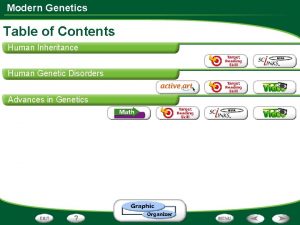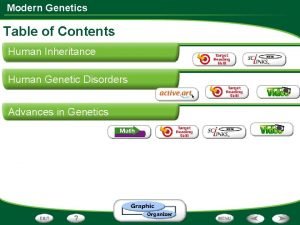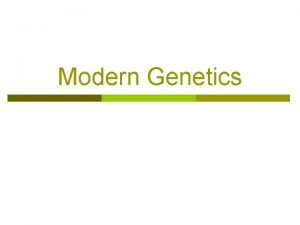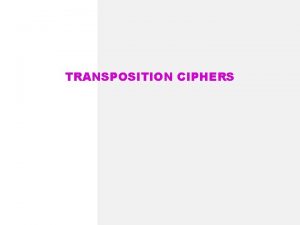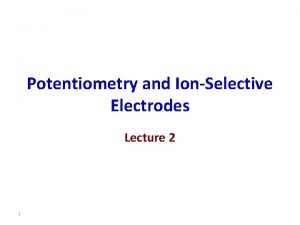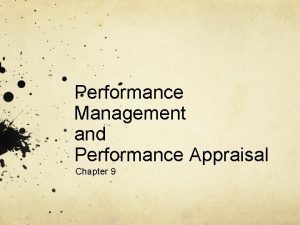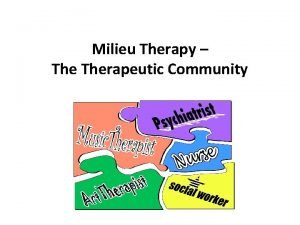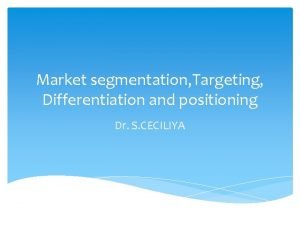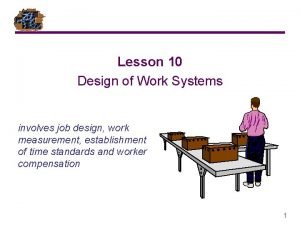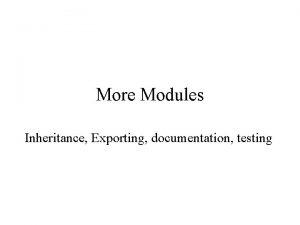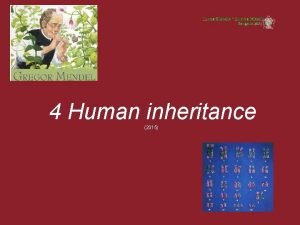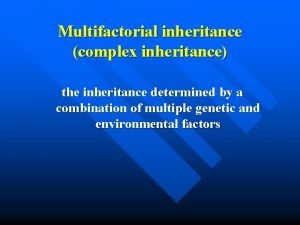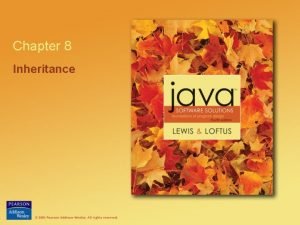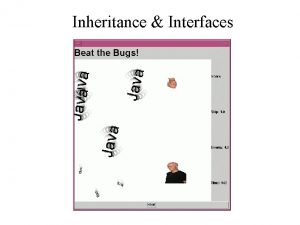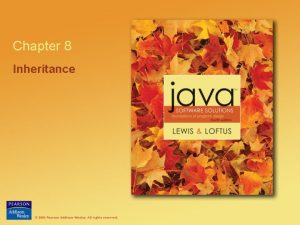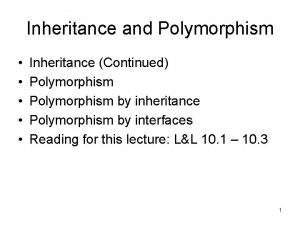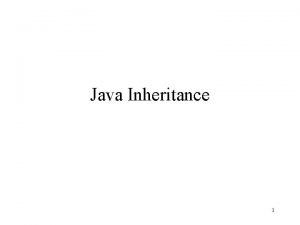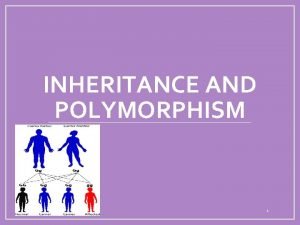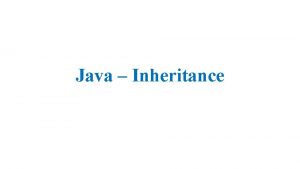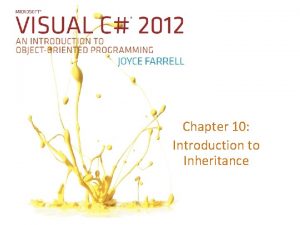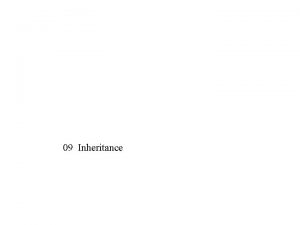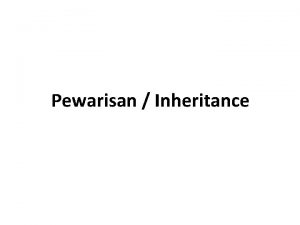Ch 14 Human Inheritance Human inheritance involves more


















![Changes in Chromosome Number • Down Syndrome [Trisomy 21]: 3 copies of chromosome 21 Changes in Chromosome Number • Down Syndrome [Trisomy 21]: 3 copies of chromosome 21](https://slidetodoc.com/presentation_image_h2/6a877ad52ab227c709648e5f8a52a306/image-19.jpg)
















- Slides: 35

Ch 14 Human Inheritance • Human inheritance involves more issues than pea plants • Relatively few traits follow a Mendelian inheritance pattern, but we cannot ethically perform test crosses • Most human traits are polygenic • Influenced by multiple genes and can be influenced by environmental factors • Inheritance can be autosomal dominant, autosomal recessive, or sex-linked

Autosomal Dominance Pattern • Autosomal dominance pattern • Caused by ONE dominant allele • Those who do not have the disorder are homozygous recessive. • BB – Disease, Bb – Disease, bb – Normal • Trait appears in every generation • If one parent is heterozygous, and the other is homozygous recessive, each child has a 50% chance of inheriting the dominant allele

Autosomal Dominant Disorders • Achondroplasia: form of hereditary dwarfism caused by mutations in gene for a growth factor • 75% born to parents of average size • Hutchinson-Gilford Progeria: accelerated aging caused by mutation in gene for lamin A • 1 in 4 million newborns worldwide • Huntington’s Disease: impacts brain cell function • No cure, but medications to cope with symptoms • People usually die 15 -20 years after onset of degeneration

Autosomal Recessive Pattern • Two recessive alleles, one from each parent • If an individual is heterozygous, they are a carrier (they could pass it on even if they don’t have it!) • BB – Normal, Bb – Normal, but a carrier, bb – Disease • Often skips a generation • Each child of two carriers has a 25% chance of being homozygous

Autosomal Recessive Disorders • Tay-Sachs Disease: caused by mutation in enzyme that breaks down a particular type of lipid • 1 in 300 of general population carries the allele, 1 in 30 Jews of eastern European descent carries the allele • Buildup of fatty acids in brain, cherry red spot on back of eye, Causes deafness, blindness, severe retardation, and death usually by age 4 • Most carriers choose to avoid birth • Albinism: caused by mutations that reduce melanin synthesis

X-Linked Recessive Pattern • Also called SEX-linked • Allele is inherited on the X chromosome • Most are recessive because dominant alleles would be lethal to male embryos

X-Linked Recessive Pattern • X-linked recessive disorders tend to appear in men more often than women because they only have one X • Women have two (XX), so they can be heterozygous (carrier) for a recessive allele • Men can transmit an X-linked allele to daughters, but not to sons–only a woman can pass an X-linked allele to a son

X-Linked Recessive Disorders • Red-Green Colorblindness: confuse red and green colors; others see green as shades of gray, but perceive blues and yellows quite well • Duchenne Muscular Dystrophy: causes the protein dystrophin to be absent • Muscle and nerve cells become replaced by fat cells • Affects 1 in 3, 500 people, mostly boys • Wheelchair by age 12, and die from a heart disorder or respiratory failure before age 30

X-Linked Recessive Disorders • Hemophilia: Disorders in which the blood does not clot properly • Males and homozygous females have prolonged bleeding • Affected people bruise easily, but internal bleeding is their most serious problem • Common in royal families of Europe and Russia during 19 th century

Patricia is a healthy carrier of hemophilia, Sam is healthy. Complete the Punnett square below. • Mom’s genotype? Dad’s genotype? • What is the probability of getting: • Daughter with hemophilia? Son with hemophilia? Carrier? Healthy child? Judy is homozygous recessive for colorblindness and Dennis is healthy. Complete the Punnett square below. • Mom’s genotype? Dad’s genotype? • What is the probability of getting: • Colorblind daughter? Color blind son? Carrier? Heterozygous child?

Pedigrees • Geneticists often use historical records to study human traits • Pedigree: Diagram that traces the inheritance of a particular trait through several generations of the same family • Determine the probability that a trait will recur in future generations • Predict probability that a disorder will reappear


Pedigrees • Individuals are in birth order from left to right (oldest at left, youngest on right) • Individuals are numbered, Generations are numbered with roman numerals • When referring to an individual, use the generation number, then the individual number • II-4

Pedigrees • From a pedigree, you can tell whether a family carries an autosomal dominant/recessive disorder, or sex-linked disorder • Autosomal or Sex-linked: • Autosomal – shows in both sexes equally • Sex-linked – show mostly in males • Dominant or Recessive: • Dominant – every individual with trait has parent with trait • Recessive – individual with trait has parent without trait


Changes in Chromosome Number • Abnormal events can occur before/during meiosis causing a new individual to have the wrong chromosome number • Nondisjunction: Failure of sister chromatids or homologous chromosomes to separate during nuclear division • Changes in chromosome number are usually caused by nondisjunction • Affects chromosome number at fertilization and causes genetic disorders among resulting offspring

Changes in Chromosome Number

Changes in Chromosome Number • Polyploidy: Individuals have three or more of each type of chromosome • Lethal in humans, many flowering plants, and some insects, fishes, and other animals, are polyploidy • Aneuploidy: individual’s cells have too many or too few copies of a chromosome • Most cases of autosomal aneuploidy are lethal in embryos
![Changes in Chromosome Number Down Syndrome Trisomy 21 3 copies of chromosome 21 Changes in Chromosome Number • Down Syndrome [Trisomy 21]: 3 copies of chromosome 21](https://slidetodoc.com/presentation_image_h2/6a877ad52ab227c709648e5f8a52a306/image-19.jpg)
Changes in Chromosome Number • Down Syndrome [Trisomy 21]: 3 copies of chromosome 21 • Mild to moderate mental impairment • Health problems such as heart disease • Flattened facial profile; fold of skin on inner corner of eye • Low muscle tone • Occurs in 1 in 700 births; risk increases with maternal age

Changes in Chromosome Number • Edward’s Syndrome - Trisomy 18: almost every organ system affected 1: 10, 000 live births. Children with full Trisomy 18 generally do not live more than a few months. • Patau Syndrome - Trisomy 13: serious eye, brain, circulatory defects as well as cleft palate. 1: 5000 live births. Children rarely live more than a few months

Sex Chromosome Changes • Changes in sex chromosomes usually result in some degree of impairment in learning and motor skills • Turner Syndrome (XO): Well proportioned but short, Ovaries do not develop properly, Insufficient sex hormones to become sexually mature • XXX syndrome: Mild mental impairment, Usually no physical or medical problems • Klinefelter syndrome (XXY): Overweight and tall; normal intelligence, make more estrogen and less testosterone than normal males, which has feminizing effects • XYY Syndrome: Taller than average, mild mental impairment

Genetic Screening • Can estimate probability that a child will inherit a genetic disorder • Some disorders can be detected early enough to start countermeasures before symptoms develop • Testing of an embryo or fetus can reveal genetic abnormalities or disorders before birth • Obstetric sonography, Fetoscopy, Amniocentesis, Chorionic villus sampling (CVS)

Genetic Testing • You can have your own genes tested to determine if you carry specific genes • Though you may carry a certain gene, many traits arise from a complex interplay of your genes and your environment • Angelina Jolie discovered she carried the BRCA 1 mutation associated with an 87% lifetime risk of developing breast cancer • You could carry an allele for Alzheimer’s however it is only a risk, there is no guarantee you will develop the disease

CH 15 Genome • Genome: an organism’s entire set of genetic material, consists of thousands of genes • A genomic library collectively contains all DNA in a genome • The human genome consists of about 3 billion nucleotide bases • 50 years after discovery of DNA structure, sequencing of the human genome was complete [2003]

Genomics • Genomics: The study of whole-genome structure and function • First human genome sequence took 15 years; takes about a day now • Whole-genome comparisons can provides insights into evolution and medical benefits • We have learned the function of human genes by studying counterpart genes in other species

Genomics • Your genome remains constant, however gene expression is not • About 99% [~2. 97 billion nucleotides] of your DNA is the same as everyone else’s, the differences [~30 million nucleotides] make you unique • Most alleles for a gene differ by only one nucleotide, which is the basis of variation in human traits • DNA Profiling: Identifies a person by their DNA • “DNA fingerprint profile” in criminal investigation

Genetic Engineering • Genetic Engineering: Process by which an individual’s genome is deliberately modified [changed] • Produces a genetically modified organism (GMO) • A gene may be altered or reinserted within the same species • Transferring a gene from one species to another (transgenic) • GM plants are engineered for drought tolerance, resistance to diseases, and added nutrition

Genetic Engineering • GM microorganisms make enzymes that slow the staling of bread or improve the taste of juice • GM animals include goats that make proteins to treat cystic fibrosis, heart attacks, and clotting disorders, pigs with heart-healthy fat and lower phosphate feces, faster growing salmon, and farm animals that produce more meat or milk

Editing Genomes • Gene therapy: Gene is transferred into body cells to correct a genetic defect or treat a disease • Tested as a treatment for heart attack, sickle-cell anemia, cystic fibrosis, hemophilia A, Parkinson’s and Alzheimer’s diseases, several cancers, and inherited diseases • Designer Babies: using genetic engineering to choose the traits of your offspring • Savior Siblings: children conceived with the initial purpose of acting as donors for a sick brother or sister.

Biotechnology • Biotechnology: technical manipulation of application of biological systems • Breeding: the bringing together of two living things to produce offspring • Selective breeding: can bring out the desired traits of living things • examples: dog breeding, agriculture, hybridization • Inbreeding: process in which closely related organisms are bred to ensure inheritance of desired traits and elimination of undesired traits • Can be harmful, inheritance of recessive traits

Cloning DNA • Restriction Enzymes: cut DNA at a specific nucleotide sequence creating manageable DNA chunks • Recombinant DNA: combines segments of DNA from different sources • DNA from two sources cut into fragments; leaves “sticky ends, ” fragments are mixed, matching sticky ends base pair with each other, DNA ligase seals the base-paired DNA fragments • DNA cloning mass produces specific DNA fragments and a huge population of clones can be grown

Biotechnology • DNA sequencing allows us to determine the order of nucleotides in a molecule of DNA • Gel Electrophoresis: electric current is used to separate DNA fragments according to size • Electric field pulls DNA fragments through gel, fragments of different sizes move at different rates (shorter moves through faster) • Fragments of the same length gather into bands

CRISPR • Powerful new method for editing chromosomal DNA • RNA guides a restriction enzyme to a piece of DNA, the enzyme cuts the DNA at that a certain spot • A new piece of DNA is put there to repair the break • Most important part is the RNA and DNA can be designed to precisely target and change and essential part of the genome • HIV could be edited out of a person’s cells to prevent relapse • Mutations could be removed to cure genetic disorders

https: //www. youtube. com/watch? v=j. Ahj. Pd 4 u. NFY#action=sh

Concerns with Altering Genomes • Concern that altering genomes in any way has us on a slippery slope that may result in irreversible damage to ourselves and to the biosphere • An oversight could, for example, deliver unwanted genetic modifications into humans
 Lirik lagu more more more we praise you
Lirik lagu more more more we praise you More more more i want more more more more we praise you
More more more i want more more more more we praise you Human history becomes more and more a race
Human history becomes more and more a race Human inheritance modern genetics answer key
Human inheritance modern genetics answer key Human clone
Human clone Modern genetics human inheritance answer key
Modern genetics human inheritance answer key Chapter 11 complex inheritance and human heredity test
Chapter 11 complex inheritance and human heredity test Chapter 11 section 1 basic patterns of human inheritance
Chapter 11 section 1 basic patterns of human inheritance Chapter 11 section 1 basic patterns of human inheritance
Chapter 11 section 1 basic patterns of human inheritance The more you take the more you leave behind
The more you take the more you leave behind The more you study the more you learn
The more you study the more you learn Aspire not to
Aspire not to More mass more inertia
More mass more inertia Knowing more remembering more
Knowing more remembering more The more i give to thee the more i have
The more i give to thee the more i have More choices more chances
More choices more chances Route cipher
Route cipher It refers to dry heat cooking
It refers to dry heat cooking Parts of nursing diagnosis
Parts of nursing diagnosis 000 budget scorekeepers are under pressure
000 budget scorekeepers are under pressure Different method of size separation of
Different method of size separation of Comparing figures of speech
Comparing figures of speech Remedial teaching methods
Remedial teaching methods Potential of the glass electrode is given by
Potential of the glass electrode is given by Fire extinguisher basics
Fire extinguisher basics Potential rating scale appraisal problems
Potential rating scale appraisal problems Therapeutic community and milieu therapy
Therapeutic community and milieu therapy Encoding in communication process
Encoding in communication process Positioning involves meeting consumers lower performance
Positioning involves meeting consumers lower performance The design of work systems involves
The design of work systems involves Temporal ellipsis in film
Temporal ellipsis in film A cheat cut involves
A cheat cut involves Inductive reasoning involves
Inductive reasoning involves Luksong baka rules
Luksong baka rules Monohybrid and dihybrid cross
Monohybrid and dihybrid cross Process of discovery in reading
Process of discovery in reading



